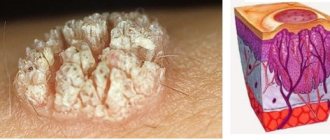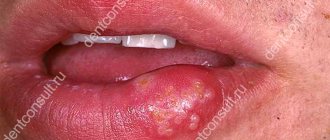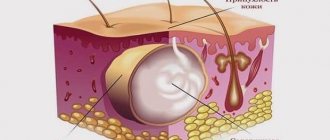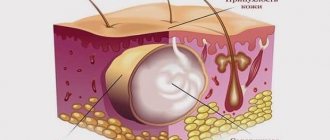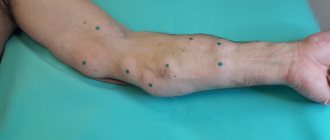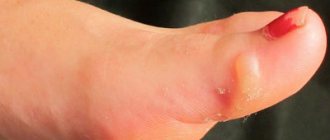Any punctured, chopped, torn or cut wound can be complicated by the process of suppuration. Even if you cut your finger with a knife in the kitchen, you should not think that this is a trifle, because an insufficiently treated wound can fester. Everyone should know the first symptoms of wound suppuration for the reason that in most cases this problem has to be solved exclusively by surgery.
This problem is especially relevant for those who have undergone any surgery and were discharged home after rehabilitation. If postoperative sutures are not cared for at home as prescribed by the doctor, then if an infection occurs, suppuration may begin. Contrary to the generally accepted opinion of patients, suppuration after operations begins not because of the conditions during the operation, but precisely due to the fault of patients who irresponsibly approach the doctor’s prescriptions when they find themselves at home.
During surgery, it is essential to maintain absolute sterility, and this principle is never violated. Medical doctors recommend that you always fully follow the prescriptions they make to avoid such serious complications.
What is a purulent wound?
A purulent wound is a wound in which an infection has developed. Infection is accompanied by the formation of pus and inflammation, which is easily noticeable at the edges of the wound. Purulent wounds can be infected from the moment the injury is caused, or they can be the result of infection of an initially clean wound, such as a surgical wound. The percentage of suppuration of surgical wounds is quite high even today - up to 30%, despite maintaining sterility.
A particular danger of purulent wounds is that the processes of absorption of decay products occurring in them can lead to severe general intoxication, and in the absence of proper treatment, to death. Purulent wounds often cause sepsis - blood poisoning.
Classification
An infected wound on the leg may have various signs of suppuration, which are taken into account during treatment. In addition to symptomatic manifestations, the classification is based on the etiology and route of entry of the pathogen.
Types of purulent lesions:
- boil - purulent inflammation in a limited capsule, more often manifested in people with reduced immunity;
- carbuncle - suppuration with several purulent “rods”, limited by a fibrous membrane;
- phlegmon is an unlimited large abscess that can develop when the periosteum is damaged;
- hidradenitis – inflammation of the sweat glands, found in the groin area;
- abscess - a purulent process that develops as a result of incorrect injection, when the leg is punctured with a sharp object;
- panaritium - purulent inflammation is fixed on the toes near the nail bed.
Causes of purulent wounds
The immediate cause of the development of suppuration in the wound is the entry of pathogenic microorganisms into it and their reproduction. Today in traumatology and surgery it is generally accepted that any accidental (i.e. not caused for medical purposes, not surgical) wound is infected - it contains one or another amount of bacteria. However, not every wound suppurates, since for suppuration a simultaneous combination of several factors is necessary: • a severe degree of tissue damage; • the presence of dead tissue and/or bleeding in the wound; • the presence of dead tissue and/or bleeding in the wound; • high concentration of pathogenic microorganisms.
According to research results, for the development of infection in normal undamaged tissues, a concentration of microbes in a volume of 100 thousand microbial bodies per 1 gram of tissue is required. More precisely, this is the so-called critical level of bacterial contamination, when exceeded, the inflammatory process begins. However, this level can decrease under certain conditions: • if there are foreign bodies or bleeding in the wound, the critical level decreases to 10 thousand microbes per 1 gram of tissue; • with ligature ischemia - disruption of the blood supply to tissues in the area where the ligature is tied - the level decreases to 1 thousand microbes per 1 gram.
Many other factors also influence the likelihood of developing suppuration.
1. Nature of the wound. Most often, lacerated and lacerated wounds fester due to the large amount of damaged and dead tissue; Also, such wounds are more often accompanied by contamination. Puncture wounds suppurate with a similar frequency - due to the long and thin wound channel in which purulent exudate accumulates, and a small hole in the skin that impedes its outflow. Suppuration is most rarely observed on incised wounds.
2. Location of the wound. The lower the wound is on the body, the greater the risk of suppuration. Most often, wounds fester on the feet, somewhat less often on the stomach, back, chest, and arms. The risk is lowest for head and neck wounds.
3. General condition of the body. Low immunity and general weakness increase the risk of suppuration. With good immunity, the body is able to cope even with significant bacterial insemination - the inflammatory process will proceed more violently, but quickly and will not spread to surrounding tissues.
4. Presence of somatic diseases. In addition to acute conditions that reduce immunity, chronic diseases increase the risk of suppuration and reduce the rate of healing. Diabetes mellitus is especially dangerous in this regard - due to metabolic disorders, tissues regenerate extremely slowly, and suppuration and inflammation develop even with minor wounds.
5.Age. The older a person is, the higher the risk of developing infection.
6. Build. Obese people have a higher risk of developing infection than thin people.
7. Environmental conditions. At high temperatures and humidity, the likelihood of suppuration increases.
All these factors must be taken into account when starting treatment.
Inflammation and suppuration are most often caused by bacteria such as streptococci, staphylococci, Klebsiella, Proteus, and Escherichia coli. These microorganisms are classified as a special category of pyogenic bacteria. However, in certain cases, suppuration can also be caused by other bacteria - pneumococci, shigella, salmonella.
Symptoms of purulent wounds
Symptoms of purulent wounds are usually divided into local (characteristic of the wound itself) and general.
Local symptoms include: • formation of purulent exudate; • hyperemia; • swelling; • temperature increase; • pressing or bursting pain.
If the inflammatory process in the wound drags on, the redness around it becomes purple and cyanosis appears.
The edematous tissues directly in the area of injury are warm, and at some distance from it they are distinctly cold as a result of a reactive decrease in temperature.
General symptoms are manifestations of intoxication of the body with decay products that come from the wound. Common symptoms include: • increased body temperature; • lack of appetite; • nausea; • muscle weakness; • sweating; • fever; • chills; • headache.
In case of severe intoxication, symptoms such as severe weakness, mental disorders (hallucinations, delusions of persecution), confusion and even coma may be observed.
Treatment of purulent wounds
When treating purulent wounds, the stage of the wound process should be taken into account. The wound process is a complex of reactions of the body to tissue damage. This process is conditionally divided into three phases: • inflammation phase; ○ stage of vascular changes; ○ stage of wound cleansing; • regeneration phase; • phase of scarring and epithelization.
In the first phase - the phase of inflammation - the formation of purulent exudate occurs with the simultaneous absorption of toxic substances. At this stage, the main task is to cleanse the wound - remove purulent masses and remnants of dead tissue, wash and drain the wound, and stop bleeding. Also at this stage it is necessary to limit and reduce inflammation as much as possible and destroy pathogenic microflora. To disinfect and ensure the outflow of fluid, antibacterial hydrophilic ointments are used, for example, levomekol or ready-made dressings - Voskopran with ointments levomekol, povidone-iodine or Dioxidin.
In the second phase, thin and delicate connective tissue with capillaries begins to form on top of the wound - granulation. At this stage, it is necessary to protect the newly formed tissue from damage, stimulate further regeneration and prevent the resumption of the inflammatory process. Healing-accelerating agents help stimulate regeneration - methyluracil ointment or Voskopran dressing with methyluracil ointment; dressings also help protect newly formed tissues.
The third phase is the formation of dense scar tissue over the wound and the beginning of epithelization. At this stage, it is necessary to accelerate epithelization and wound healing.
In the treatment process, the correct selection of dressings plays an important role. Dressing material for purulent wounds must meet the following requirements: • have high absorbency; • hold the medicinal product on its surface for a long time; • do not leave fibers; • allow oxygen to pass through, allowing the wound to “breathe”.
Medical dressings meet all of the above requirements. The range includes suitable dressings for the management of purulent wounds at all stages.
For the first phase, a Parapran dressing with chymotrypsin is well suited - it removes exudate into a secondary sorption dressing and has a necrolytic effect, helping to break down dead tissue and cleanse the wound, as well as Voskopran with various ointments: levomekol - anti-inflammatory effect; povidone-iodine and Dioxidin - antimicrobial action. For wounds with heavy exudation, Medisorb is recommended as a secondary dressing, a sorption dressing characterized by high absorbency.
In the second phase, it is recommended to use Voskopran with methyluracil ointment, which stimulates wound healing.
In the third phase, you can use a regular Voskopran dressing without ointment to speed up the epithelization process and protect the scar from mechanical damage.
Chitopran, a thin biopolymer dressing that stimulates and accelerates the healing process, is well suited for the management of difficult-to-heal wounds in the granulation stage. It creates a sterile environment with an optimal level of humidity that promotes epithelialization. The material is extremely thin and flexible, which allows it to be used by patients with fragile and sensitive skin. There is no need to remove the bandage - the material is absorbed naturally.
Methods for softening the crust
You can soften the scab on the wound for subsequent removal in the following ways:
- If a crust has formed on your leg, you can steam it in water with the addition of soda and laundry soap. Then treat the damage with ointment.
- Softening crusts from wounds on the face after acne removal with Chlorohexidine. A sterile bandage is generously moistened in the solution and applied to soften the scab, then removed.
- You can soften the scab with healing ointments, the doctor will tell you the name, when using them you need to follow the instructions.
Prevention of purulent wounds
In order to prevent suppuration of wounds, it is recommended to carry out prophylactic antibiotic therapy. Such therapy is indicated in situations of general weakening of the body: anemia, immunodeficiency states, and chronic diseases. In surgical practice, prophylactic antibiotic therapy is carried out during laparoscopic operations, such as removal of appendicitis, suturing of ulcers, etc. Also, to reduce the risk of infection, the area of skin that will be affected during the operation is treated with antiseptics in advance.
If you are injured, then it is necessary, in order to avoid suppuration, to stop the bleeding as soon as possible, treat the wound with an antiseptic, remove any existing contamination, and apply an antimicrobial bandage to the wound itself.
If foreign bodies get into the wound, it is not recommended to remove them yourself - this can only increase the risk of infection. In such a situation, you need to consult a doctor. If the foreign body is large and protrudes from the wound, it must be secured with a bandage before transporting the patient to the doctor.
When a scab is a problem
What is a scab? This is a natural function of the body. The main purpose of the skin is protection. Therefore, the scab, which protects the body from the entry of pathogenic bacteria from the outside, is important for ensuring this function. And in most cases there is no need to interfere with the natural wound healing process.
But there are exceptions to the rule. For example, the wound may not crust over, but remain wet or inflammation may begin underneath it. If the affected area is large, the scab can cause serious inconvenience. Then you will need the help of a specialist who will cut it. Sometimes this procedure is performed as an emergency measure when a scab interferes with adequate blood supply.

